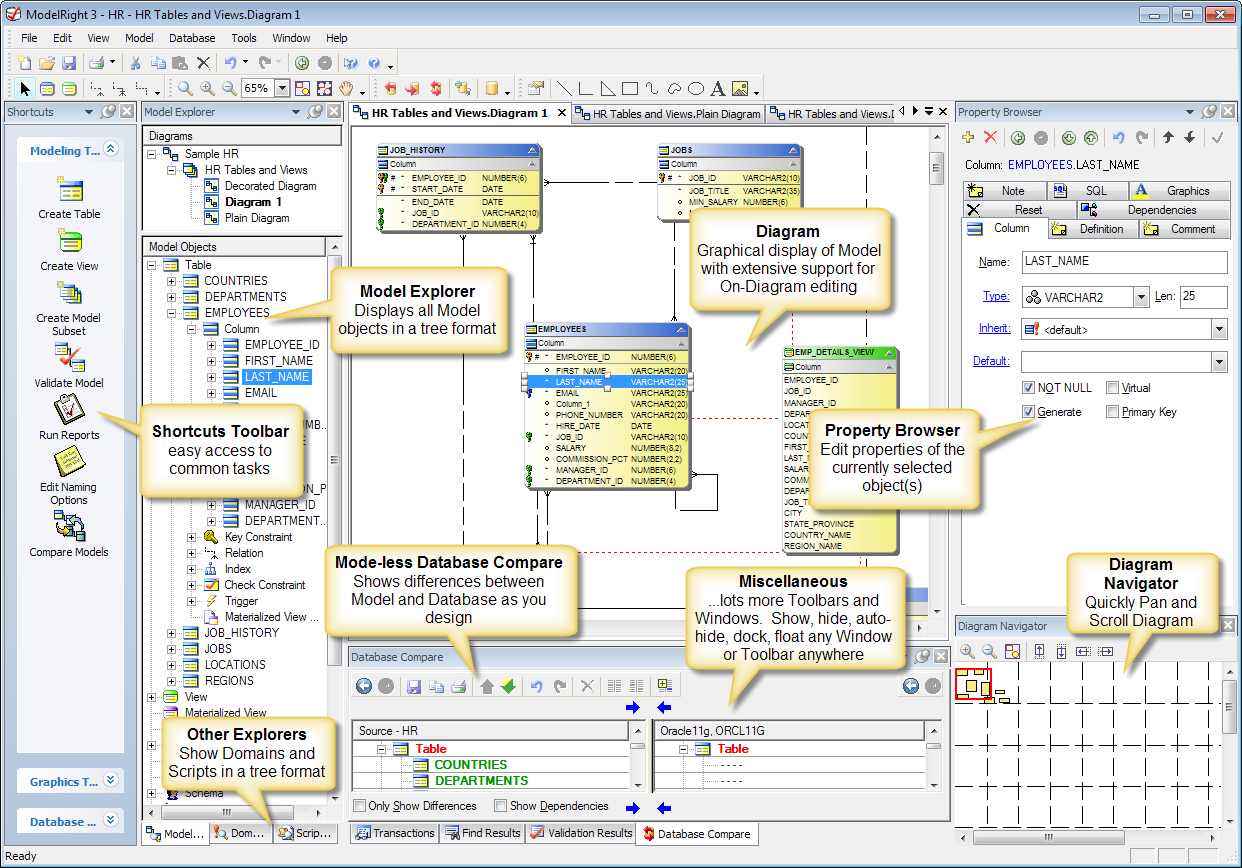
- #Oracle sql developer er diagram mac os x#
- #Oracle sql developer er diagram install#
- #Oracle sql developer er diagram zip file#
- #Oracle sql developer er diagram full#
- #Oracle sql developer er diagram plus#
If you make changes to an object and click the X, you are asked if you want to save the changes. To switch among objects, click the desired tabs to close a tab, click the X in the tab. The right side of the Data Modeler window has tabs and panes for objects that you select or open, as shown in the following figure, which displays information about a deliberately oversimplified relational model for library-related data (the model developed in Chapter 2, "Tutorial: Data Modeling for a Small Database"). To select an object in the object browser, expand the appropriate tree node or nodes, then click the object. The left side of the Data Modeler window has an object browser with a hierarchical tree display for data modeling objects, as shown in the following figure. The actions for the icons are also available from the Object menu. To see the name of any icon, hover the pointer over the icon. For example, for a relational model the icons include New Table, New View, Split Table, Merge Tables, New FK Relation, and Generate DDL. Icons under the menus perform actions relevant to what is currently selected for display on the right side of the window, such as the logical model, a relational model, or a data flow diagram. You can also display the File menu by pressing the F10 key.

You can use shortcut keys to access menus and menu items: for example Alt+F for the File menu and Alt+E for the Edit menu or Alt+H, then Alt+C for Help, then Contents.
#Oracle sql developer er diagram plus#
The menus at the top contain some standard entries, plus entries for features specific to SQL Developer Data Modeler (see Section 1.2.1, "Menus for Data Modeler"), as shown in the following figure. (For more advanced tutorials and other materials, see Section 1.9, "Additional Resources for Data Modeling".)įigure 1-1 SQL Developer Data Modeler Main Window If you want to become familiar with data modeling concepts before using the interface, read the rest of this chapter before proceeding to the next step.ĭo the short tutorial in Chapter 2, "Tutorial: Data Modeling for a Small Database". For example, on a Windows system the path might have a name similar to C:\Program Files\Java\jdk1.6.0_06\bin\java.exe.
#Oracle sql developer er diagram full#
If you are asked to enter the full pathname for java.exe, click Browse and find java.exe. On Windows systems, double-click datamodeling.exe.
#Oracle sql developer er diagram mac os x#
On Linux and Mac OS X systems, run sh datamodeling.sh. To start Data Modeler, go to the datamodeling directory under the directory, and do one of the following: It also causes many files and folders to be placed in and under that directory. Unzipping the Data Modeler kit causes a directory named datamodeling to be created under the directory. For example, on a Windows system you might want to choose C:\Program Files as this location. This directory location will be referred to as. Unzip the Data Modeler kit into a directory (folder) of your choice. You should read any Data Modeler release notes or "readme" file before you perform the following steps.
#Oracle sql developer er diagram zip file#
zip file and unzip it into a desired parent directory or folder, and then type a command or double-click a file name.

#Oracle sql developer er diagram install#
To install and start SQL Developer Data Modeler, the process is similar to that for SQL Developer: you download a. Section 1.9, "Additional Resources for Data Modeling"ġ.1 Installing and Getting Started with SQL Developer Data Modeler Section 1.8, "Read-Only Data Modeler Viewer" Section 1.6, "Saving, Opening, Exporting, and Importing Designs" Section 1.5, "Data Modeler Options (User Preferences)" Section 1.4, "Approaches to Data Modeling"

Section 1.3, "Working with SQL Developer Data Modeler" Section 1.2, "Data Modeler User Interface" Section 1.1, "Installing and Getting Started with SQL Developer Data Modeler" This chapter contains the following major sections: However, a free viewer (read-only) version is also available, as explained in Section 1.8. SQL Developer Data Modeler is a for-cost option of SQL Developer that requires a separate license. It is based on the Zachman framework and the Object Management Group (OMG) MetaObject Facility (MOF) and Common Warehouse Metamodel (CMW) specifications. SQL Developer Data Modeler is a data modeling and database design tool that provides an environment for capturing, modeling, managing, and exploiting metadata.


 0 kommentar(er)
0 kommentar(er)
